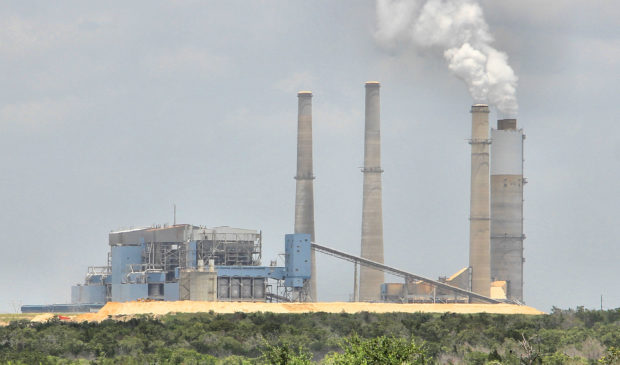An update on the Fayette Power Plant reveals no news, inspires working group
Thursday, September 20, 2018 by
Jessi Devenyns Almost five years ago, Council recommended that Austin Energy retire its portion of the Fayette Power Plant, which is run on coal, by 2022. Despite intense pressure from environmentalists to move that date up, the city utility is sticking to their plans for retirement on that date.
However, the path forward toward retirement remains clear. “We don’t believe there is a significant impediment there,” Pat Sweeney, the vice president of Power Production at Austin Energy, informed the Electric Utility Commission at its Sept. 17 meeting.
Predictably, the commissioners began asking why the utility doesn’t just shut down now. Commissioner Marty Hopkins asked what the economic exposure would be if the city defaulted on or terminated the shared contract that the city holds with the Lower Colorado River Authority at the power plant. Although Sweeney explained that he could not “speak to that as an option,” Chair Cary Ferchill noted that Austin Energy does not operate the plant in a day-to-day capacity. “If we just quit answering their phone calls, they’re going to continue operating it,” he said.
Furthermore the city, which holds the contract jointly with LCRA, still owes $160 million of outstanding debt on the facility. There are also no provisions for retirement or exit outside of a sale written into the contract.
Sweeney clarified that selling the city of Austin’s portion of the plant was not an option because anyone who bought it would continue to operate it, which would not achieve the intended goal of reducing emissions.
The continued operation of the plant was a key point for the commissioners, who questioned why the city would not only continue to use coal as long as possible, but also ramp up the percentage of coal use in its energy mix over the last year.
“It looks like it’s in the money, otherwise it wouldn’t be dispatched,” said Commissioner Dave Tuttle.
Robert Cullick, the director of communications and marketing at Austin Energy, confirmed that prices had increased. He told the Austin Monitor that in the last three to four years, the coal market has risen $3 to $4 per megawatt hour.
That increase has made Fayette $16 million more valuable as a dispatch option. Within the last year and a half, according to Commissioner Michael Osborne, the power plant’s production has increased from 60 percent and is now running at 80 percent.
In order to limit the energy production by this power plant, Commissioner Matt Weldon suggested imposing a financial incentive not to emit. He noted that the federal government already encourages environmental energy dispatch by paying $50 a ton to sequester carbon-emitting energy sources, which would be a logical path for the city to follow if it wanted to artificially “retire” Fayette early.
“We’re not going to do something that’s financially disastrous to the utility,” said Ferchill, who noted that transitioning immediately to all renewables would make the city vulnerable to seasonality and weather patterns. “We have to find a way to transition from our current asset base to our future asset base without going bankrupt,” he said. He explained that he was more than willing to discuss how to approach all renewable energy but would not do so without hard numbers “on the back of an envelope.”
Several commissioners also suggested the possibility of not just shutting down their portion of Fayette but repurposing it as an alternative energy production plant. “Solar is possible, but there’s a large body of water in the middle of it right now,” said Sweeney in response to a suggestion to install a solar farm on the 6,400-acre property. Tuttle thought outside the box and recommended using the 2,400-acre cooling lake to enhance water storage for the downstream rice farmers.
While Sweeney said that he could not speculate on alternative uses without knowledge of LCRA’s intent for the facility in the future, he did say that Austin Energy would “continue discussions with LCRA to find a mutually agreeable solution.”
Although the commissioners could not make a recommendation as to the status of the facility one way or another, they created a working group to discuss the potential for early retirement of the power plant as well as alternative uses for the facility when it is no longer producing coal energy. Weldon, Hopkins, and commissioners Erik Funkhouser and Karen Hadden will sit on that working group.
Photo by Larry D. Moore, CC BY-SA 3.0, Link.
Marty Hopkins is board member of the Capital of Texas Media Foundation, which is the Austin Monitor’s parent company. This story has been corrected to note that Hopkins did not suggest defaulting on the contract, but interrogated the potential repercussions of doing so.
The Austin Monitor’s work is made possible by donations from the community. Though our reporting covers donors from time to time, we are careful to keep business and editorial efforts separate while maintaining transparency. A complete list of donors is available here, and our code of ethics is explained here.
You're a community leader
And we’re honored you look to us for serious, in-depth news. You know a strong community needs local and dedicated watchdog reporting. We’re here for you and that won’t change. Now will you take the powerful next step and support our nonprofit news organization?








